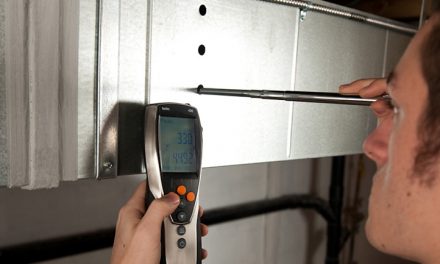Each of these questions can lead to discussions that engage customers deeper into the diagnostics and the solution. Take time to explain and discover with them. Can you see what’s happening?
Simple Deeper Diagnostics
Each diagnostic test has a cousin test that reveals a little more of the picture. If your Learn-O-mercial is working, customers will eagerly engage in some very simple diagnostics with you. Invite them to join in the discovery process and get them up and moving with you.
The diagnostics sales lead comes from a discovery process which may be a simple inspection of a suspected problem you identified together. Maybe the two of you check whether that new filter is restrictive. Or maybe you both take a static pressure profile at the equipment if it is accessible or finding closed dampers.
My favorite approach is taking the customer into the most uncomfortable room, then helping them estimate airflow.
For example, say you help them calculate 125 beach balls of air per minute (read ncilink.com/beachballs for a full explanation). Then invite them to measure the register airflow with a balancing hood.
Be still. Say nothing when the hood measures just 38 and watch the Learn-O-mercial work its magic.

Measure supply and return duct static pressures and compare your results to 20% of rated static pressure. Be sure you teach them what the maximum pressure should be before measuring it. When it’s high, ask them what might cause the high pressure. Be patient and give hints to help them find solutions when appropriate.
If duct temperature loss is the initial diagnosis, one quick and effective diagnostic you can do together is to place a temperature probe in a return grille and supply register farthest from the equipment.
Set the system to fan only and let it run. When duct heat gain or loss is present, the home gets uncomfortable in a few minutes. Calculate the difference between the supply and return air. It should be zero. Watch their faces as they learn and let the test data build their desire to own a solution.
When you allow customers to discover a system defect through diagnostics, they become highly motivated to fix the system. They’re not buying your recommendation; they want to hire you to repair the problem they discovered themselves.
But When Do I Start Selling?
Did you miss it? It already happened. The customer made the sale for you as they participated in your Learn-O-mercial. They learned about their system and decided they wanted the solutions only you can offer. That is the heart of the diagnostics sales lead.
Each time you help customers discover system defects, they decide to buy independent of you. It’s the events you coached them through that did the selling. They want the sale each time they ask, “Can you fix this?”
Everything Else is Paperwork
During the Learn-O-mercial, it’s your job to take notes to define the work for the inventory team and installers. You form the scope of work while you uncover each system defect to be corrected. NCI has reports to help you identify the scope of work.
As each flaw is uncovered during diagnostics, briefly explain to your customer how you’ll fix it. They usually don’t care; they want to hear you are fully qualified to make the repair.
It’s not time to write a proposal yet. It is time to talk about the customer’s repair priorities. Price comes up at this point. So, pull out your phone and answer the six questions in your trusty NCI Air Upgrade Price Calculator or use your flat-rate pricing. Discuss and agree upon upgrade priority and price.
Lock down any outstanding decisions such as financing, project start/end date, construction details, and commitments for both of you.
Click Below for the Next Page:













Recent Comments